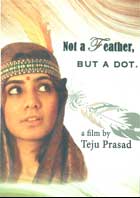
Not a Feather, but a Dot 2012
Distributed by Not a Feather, LLC
Produced by Julie Almendral
Directed by Teju Prasad
DVD , color, 60 min.
Sr. High - General Adult
Anthropology, Asian Studies, Multicultural Studies, Sociology
Date Entered: 12/05/2012
Reviewed by Wendy Highby, University of Northern ColoradoNot a Feather, but a Dot is a film about the prevalence of Indian-American stereotypes in United States culture. The title refers to our confusingly similar nomenclature for American Indians (United States citizens descended from indigenous Native Americans) and Indian Americans (United States citizens descended from natives of the southern Asian country of India). Our use of visual and verbal shorthand intensifies stereotypes. We reduce a culture’s expression of its connection to nature to an iconic feather; likewise, we dilute the spiritually symbolic bindi to a fashionable dot. Teju Prasad both directs and narrates the documentary, occasionally interjecting his personal experiences. Prasad’s dual roles as director and Indian-American subject intensify the film’s potential to evoke empathy from its audience. The film deftly walks the line between seriousness and humor; it is didactic, but in a cleverly entertaining manner.
The editorial mix of personal experience, expert talking heads, and humor is nicely balanced. Prasad’s skill as an interviewer is evident in the relaxed and informative conversations he evokes. Some of the featured experts include: Vineet Chander, Princeton University Hindu Life Coordinator; Sgt. Mahaan Chandu, NYPD; Psychologist Dr. Nilanjana Dasgupta, University of Massachusetts, Amherst; Jay Goyal, State Representative for Ohio; Dr. Balaji Hebbar, Religion Department, George Washington University; Anjul Nigam, actor; Dr. Vijay Prashad, author of “Karma of Brown Folk;” and Sheetal Shah, Director of the Hindu-American Foundation. Particularly effective are Prasad’s conversations with Dr. Dasgupta in which she articulately explains the psychological aspects of stereotyping. Another highlight is Actor Anjul Nigam’s frank discussion about the vocational typecasting of Indian Americans as convenience store owners/workers, cab drivers, and technical workers. The footage with author Vijay Prashad is enlightening and provides the film’s political context. Dr. Prashad explains how human rights court cases and 20th century immigration policy affected Indian Americans. He also describes how Hindu religion influenced popular culture and why qualities of mysticism and sagacity have been unrealistically projected upon Indian-American culture.
The film’s intelligent, good-natured, and persistent probing of stereotypes is effective. Director Teju Prasad creatively debunks both positive and negative stereotypes. For example, he goes to Edison, New Jersey and conducts a Jay Leno-style man-on-the-street spelling bee to dispel the misperception that all Indian Americans are champion spellers. In another amusing segment, Prasad demonstrates that the Sanskrit-derived words “yoga,” “dharma,” “karma,” “mantra,” and “guru” are imprisoned by being trivialized by popular, postcolonial culture. In an effort to show that Indian Americans have pursued careers outside of the stereotypical convenience store/scientist mold, Prasad interviews a variety of Indian Americans in the entertainment industry: adult film actress, dancer, fashion model, musician, and sportscaster.
The film’s depth and breadth will be appreciated by educators. It would support curriculum related to cultural anthropology, ethnic studies, and sociology. The film could contextualize and enliven any classroom discussion related to 20th century immigration history and policy. It could also serve as a powerful explication of ethnic stereotypes. Attentive viewers will come away with a more accurate conception of Indian-American culture, and increased empathy and cultural competence. Viewing of Not a Feather, but a Dot is highly recommended for all.